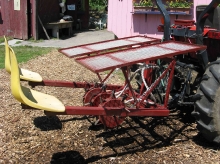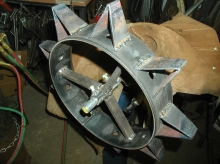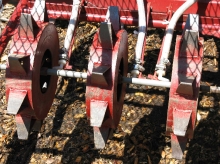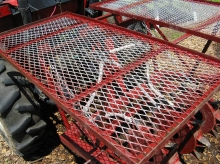I was making these because a small tractor could not carry the water wheel planters that were available commercially. Two people sit on the planter and place transplants, taken from the racks, in wet holes made by the planter’s rolling dibbles. Water is supplied to the dibbles from a water drum held in the tractor’s bucket. The tractor must have one or more creeper gears to accomodate slow travel down the bed being planted. At Stearns Farm, we used a tractor that has multiple gears under one mile per hour.
Commercial machines are sold to plant into plastic mulch. To use the machine in bare soil, the soil must be very loose for the dibble points to penetrate; a freshly roto-tilled bed works best. Nonetheless, the wheels tend to “mud-up” and the workers sitting in the seats will have to occasionally swipe at the dibble wheels to clear built up mud. In normal circumstances, transplanting with the machine is quicker and easier than manual transplanting. Some farms use the machine as a dibble, even when they are not planting with the device.
I’m no longer making these. These days, small planters like this are available from commercial sources. See RainFlo and Buckeye Tractor Company for examples.




